Enhancing Air Traffic Management and Reducing Noise Impact: A Novel Approach Integrating Băneasa Airport with Otopeni RO Airport
Abstract
:1. Introduction
2. Materials and Methods
2.1. Bucharest Henri Coanda Airport and Bucharest Baneasa—Aurel Vlaicu Approach
- 08 R–26 L: 3500 m × 45 m, 11,484 × 148 feet;
- 08 R track with a precision approach, CAT III B;
- 26 L track with a precision approach, CAT II;
- 08 L–26 R: 3500 m × 45 m, 11,484 × 148 feet;
- 08 L track with a precision approach, CAT III A;
- 26 R track with a precision approach, CAT II;
- Total airport area: 605 ha.
- Baneasa Airport Characteristics
2.2. Acoustic Solutions for Baneasa Airport
2.2.1. CFM 56 Acoustic Directivity
2.2.2. Design of Sound-Absorbing Panels
- -
- D is the distance of the plate from the rigid wall;
- -
- is the frequency of resonance;
- -
- (m) is the wavelength at resonance.
- a perforated plate, with a thickness of 1 mm × perforation diameter of 2 mm × the distance between the centers of perforations 4 mm;
- a rigid unperforated plate, with a thickness of 10 mm, and a weight of 12 kg/m2;
- distance between the two plates = 30 mm;
- minimum height = 4 m.
2.2.3. Acoustic Prediction
- Uploading the noise spectrum produced by the CFM56 turbojet engine, measured on the ground, taking into consideration the directivity and the creation of the noise contour;
- Modeling the designed screen into IMMI, incorporating the absorption coefficient, as determined in the laboratory;
- Creating the noise contour with the resonance-absorbent screen;
- Comparing the two contours and assessing the noise reduction.
3. Results and Discussion
4. Conclusions and Future Studies
Author Contributions
Funding
Institutional Review Board Statement
Informed Consent Statement
Data Availability Statement
Conflicts of Interest
References
- Available online: https://www.bucharestairports.ro/en/ (accessed on 23 July 2023).
- European Aviation Environmental Report 2019. Available online: https://www.eurocontrol.int/publication/european-aviation-environmental-report-2019 (accessed on 23 July 2023).
- Clarke, J.P. A systems analysis of noise abatement procedures enabled by advance flight guidance technology. AIAA J. Aircr. 2000, 37, 266–273. [Google Scholar] [CrossRef]
- Can, A.; Aumond, P. Estimation of road traffic noise emissions: The influence of speed and acceleration. Transp. Res. Part D Transp. Environ. 2018, 58, 155–171. [Google Scholar] [CrossRef]
- Bunn, F.; Zannin, P.H.T. Assessment of railway noise in an urban setting. Appl. Acoust. 2016, 104, 16–23. [Google Scholar] [CrossRef]
- Gagliardi, P.; Fredianelli, L.; Simonetti, D.; Licitra, G. Ads-B system as a useful tool for testing and redrawing noise management strategies at Pisa airport. Acta Acust. United Acust. 2017, 103, 543–551. [Google Scholar] [CrossRef]
- Iglesias-Merchan, C.; Diaz-Balteiro, L.; Soliño, M. Transportation planning and quiet natural areas preservation: Aircraft overflights noise assessment in a National Park. Transp. Res. Part D Transp. Environ. 2015, 41, 1–12. [Google Scholar] [CrossRef]
- Deaconu, M.; Cican, G. Turbojet Test Cell and Noise Impact Assessment in the Vicinity of Romanian Research and Development Institute for Gas Turbines COMOTI. Acoust. Aust. 2018, 46, 249–257. [Google Scholar] [CrossRef]
- Deaconu, M.; Cican, G.; Toma, A.-C.; Drăgășanu, L.I. Helicopter Inside Cabin Acoustic Evaluation: A Case Study—IAR PUMA 330. Int. J. Environ. Res. Public Health 2021, 18, 9716. [Google Scholar] [CrossRef]
- Snellen, M.; Merino-Martinez, R.; Simons, D.G. Assessment of noise variability of landing aircraft using phased microphone array. J. Aircr. 2017, 54, 2173–2183. [Google Scholar] [CrossRef] [Green Version]
- Merino-Martinez, R.; Heblij, S.J.; Bergmans, D.H.T.; Snellen, M.; Simons, D.G. Improving aircraft noise predictions considering fan rotational speed. J. Aircr. 2018, 56, 284–294. [Google Scholar] [CrossRef]
- Faiyetole, A.A.; Ibrahim, T.T. Predicting the aircraft takeoff noise level. Vibroengineering Procedia 2019, 22, 129–134. [Google Scholar] [CrossRef] [Green Version]
- Vieira, A.; Mehmood, U.; Merino-Martinez, R.; Snellen, M.; Simons, D.G. Variability of sound quality metrics for different aircraft types during landing and takeoff. In Proceedings of the 25th AIAA/CEAS Aeroacoustics Conference, Delft, The Netherlands, 20–24 May 2019. [Google Scholar] [CrossRef]
- Faulkner, J.-P.; Murphy, E. Estimating the harmful effects of environmental transport noise: An EU study. Sci. Total. Environ. 2022, 811, 152313. [Google Scholar] [CrossRef] [PubMed]
- Ozkurt, N.; Sari, D.; Akdag, A.; Kutukoglu, M.; Gurarslan, A. Modeling of noise pollution and estimated human exposure around İstanbul Atatürk Airport in Turkey. Sci. Total. Environ. 2014, 482–483, 486–492. [Google Scholar] [CrossRef] [PubMed]
- Bentes, F.M.; Heleno, T.A.; Slama, J.G. Analysis of airport noise exposure around Viracopos International Airport using geographic information systems. J. Air Transp. Manag. 2013, 31, 15–17. [Google Scholar] [CrossRef]
- Wolfe, P.J.; Kramer, J.L.; Barrett, S.R. Current and future noise impacts of the UK hub airport. J. Air Transp. Manag. 2017, 58, 91–99. [Google Scholar] [CrossRef]
- Vogiatzis, K. Airport environmental noise mapping and land use management as an environmental protection action policy tool. The case of the Larnaka International Airport (Cyprus). Sci. Total Environ. 2012, 424, 162–173. [Google Scholar] [CrossRef] [PubMed]
- Ozkurt, N.; Hamamci, S.F.; Sari, D. Estimation of airport noise impacts on public health. A case study of Izmir Adnan Menderes Airport. Transp. Res. Part D 2015, 36, 152–159. [Google Scholar] [CrossRef]
- Püschel, R.; Evangelinos, C. Evaluating noise annoyance cost recovery at Düsseldorf International Airport. Transp. Res. Part D 2012, 17, 598–604. [Google Scholar] [CrossRef]
- Rahmatian, M.; Cockerill, L. Airport noise and residential housing valuation in southern California: A hedonic pricing approach. Int. J. Environ. Sci. Technol. 2004, 1, 17–25. [Google Scholar] [CrossRef] [Green Version]
- Zhao, K.; Okolo, P.; Neri, E.; Chen, P.; Kennedy, J.; Bennett, G.J. Noise reduction technologies for aircraft landing gear-A bibliographic review. Prog. Aerosp. Sci. 2020, 112, 100589. [Google Scholar] [CrossRef]
- Cican, G.; Deaconu, M.; Crunteanu, D.-E. Impact of Using Chevrons Nozzle on the Acoustics and Performances of a Micro Turbojet Engine. Appl. Sci. 2021, 11, 5158. [Google Scholar] [CrossRef]
- Cican, G.; Frigioescu, T.-F.; Crunteanu, D.-E.; Cristea, L. Micro Turbojet Engine Nozzle Ejector Impact on the Acoustic Emission, Thrust Force and Fuel Consumption Analysis. Aerospace 2023, 10, 162. [Google Scholar] [CrossRef]
- Gasco, L.; Asensio, C.; de Arcas, G. Communicating airport noise emission data to the general public. Sci. Total Environ. 2017, 586, 836–848. [Google Scholar] [CrossRef] [PubMed]
- Mir, M.; Nasirzadeh, F.; Bereznicki, H.; Enticott, P.; Lee, S.; Mills, A. Construction noise effects on human health: Evidence from physiological measures. Sustain. Cities Soc. 2023, 91, 104470. [Google Scholar] [CrossRef]
- Basner, M.; Clark, C.; Hansell, A.; Hileman, J.I.; Janssen, S.; Shepherd, K.; Sparrow, V. Aviation noise impacts: State of the science. Noise Health 2017, 19, 41. [Google Scholar] [CrossRef] [PubMed]
- Clark, C.; Paunovic, K. WHO environmental noise guidelines for the European region: A systematic review on environmental noise and quality of life, wellbeing and mental health. Int. J. Environ. Res. Public Health 2018, 15, 2400. [Google Scholar] [CrossRef] [Green Version]
- Faiyetole, A.A.; Sivowaku, J.T. The effects of aircraft noise on psychosocial health. J. Transp. Health 2021, 22, 101230. [Google Scholar] [CrossRef]
- Basner, M.; Babisch, W.; Davis, A.; Brink, M.; Clark, C.; Jansen, S.; Stansfeld, S. Auditory and nonauditory effects of noise on health. Lancet 2013, 383, 1325–1332. [Google Scholar] [CrossRef] [Green Version]
- Swift, H. A Review of the Literature Related to Potential Health Effects of Aircraft Noise. PARTNER Project 19 Final Report; Federal Aviation Administration. Office of Environment and Energy: Washington, DC, USA, 2010.
- Jarup, L.; Babisch, W.; Houthuijs, D.; Pershagen, G.; Katsouyanni, K.; Cadum, E.; Dudley, M.-L.; Savigny, P.; Seiffert, I.; Swart, W.; et al. Hypertension and exposure to noise near airports—The HYENA Study. Environ. Health Perspect. 2008, 116, 329–333. [Google Scholar] [CrossRef]
- Schmidt, F.P.; Kolle, K.; Kreuder, K.; Schnorbus, B.; Wild, P.; Hechtner, M.; Binder, H.; Gori, T.; Munzel, T. Nighttime aircraft noise impairs endothelial function and increases blood pressure in patients with or at high risk for coronary artery disease. Clin. Res. Cardiol. 2015, 104, 23–30. [Google Scholar] [CrossRef] [Green Version]
- Babisch, W.; Pershagen, G.; Selander, J.; Houthuijs, D.; Breugelmans, O.; Cadum, E.; Vigna-Taglianti, F.; Katsouyanni, K.; Haralabidis, A.S.; Dimakopoulou, K.; et al. Noise annoyance—A modifier of the association between noise level and cardiovascular health? Sci. Total Environ. 2013, 50–57, 452–453. [Google Scholar] [CrossRef]
- Available online: https://www.bucharestairports.ro/cnab/en/general-info/air-traffic-statistics (accessed on 23 July 2023).
- Available online: https://www.bucharestairports.ro/baneasa/en/about/technical-facts (accessed on 23 July 2023).
- Available online: https://www.cfmaeroengines.com/engines/cfm56/ (accessed on 23 July 2023).
- Torija, A.; Self, R. Aircraft classification for efficient modelling of environmental noise impact of aviation. J. Air Transp. Manag. 2018, 67, 157–168. [Google Scholar] [CrossRef] [Green Version]
- Toma, A.C. Contributions on Airport Noise Monitoring and Noise Reduction in Surrounding Areas. Ph.D. Thesis, University Politehnica, Bucharest, Romania, 2011. [Google Scholar]
- Barron, R.F. Industrial Noise Control and Acoustics; Louisiana Tech University: Ruston, LO, USA, 2003. [Google Scholar]
- UNI EN ISO 10534-2; Acoustics—Determination of Sound Absorption Coefficient and Impedance in Impedance Tubes—Part 2: Transfer-Function Method. ISO: Geneva, Switzerland, 1991.
- Ciaburro, G.; Parente, R.; Iannace, G.; Puyana-Romero, V. Design Optimization of Three-Layered Metamaterial Acoustic Absorbers Based on PVC Reused Membrane and Metal Washers. Sustainability 2022, 14, 4218. [Google Scholar] [CrossRef]
- IMMI. 2016. Available online: https://www.woelfel.de/en/products/immi.html#c42646 (accessed on 20 May 2023).
- Josimovic, B.; Krunic, N.; Nenkovic-Riznic, M. The impact of airport noise as part of a Strategic Environmental Assessment, case study: The Tivat (Montenegro) Airport expansion plan. Transp. Res. Part D 2016, 49, 271–279. [Google Scholar] [CrossRef]
- Simons, D.G.; Besnea, I.; Mohammadloo, T.H.; Melkert, J.A.; Snellen, M. Comparative assessment of measured and modelled aircraft noise around Amsterdam Airport Schiphol. Transp. Res. Part D Transp. Environ. 2022, 105, 103216. [Google Scholar] [CrossRef]
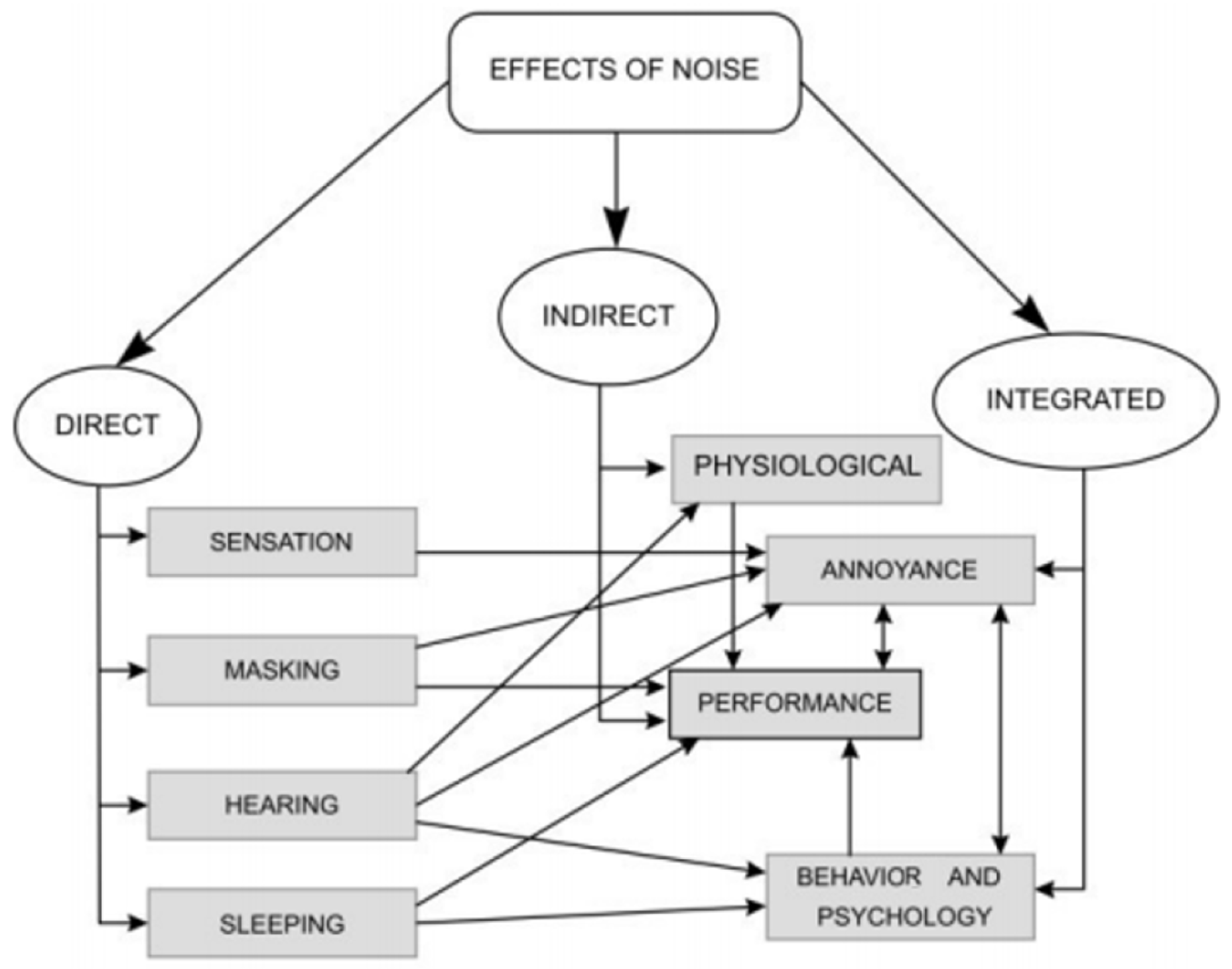




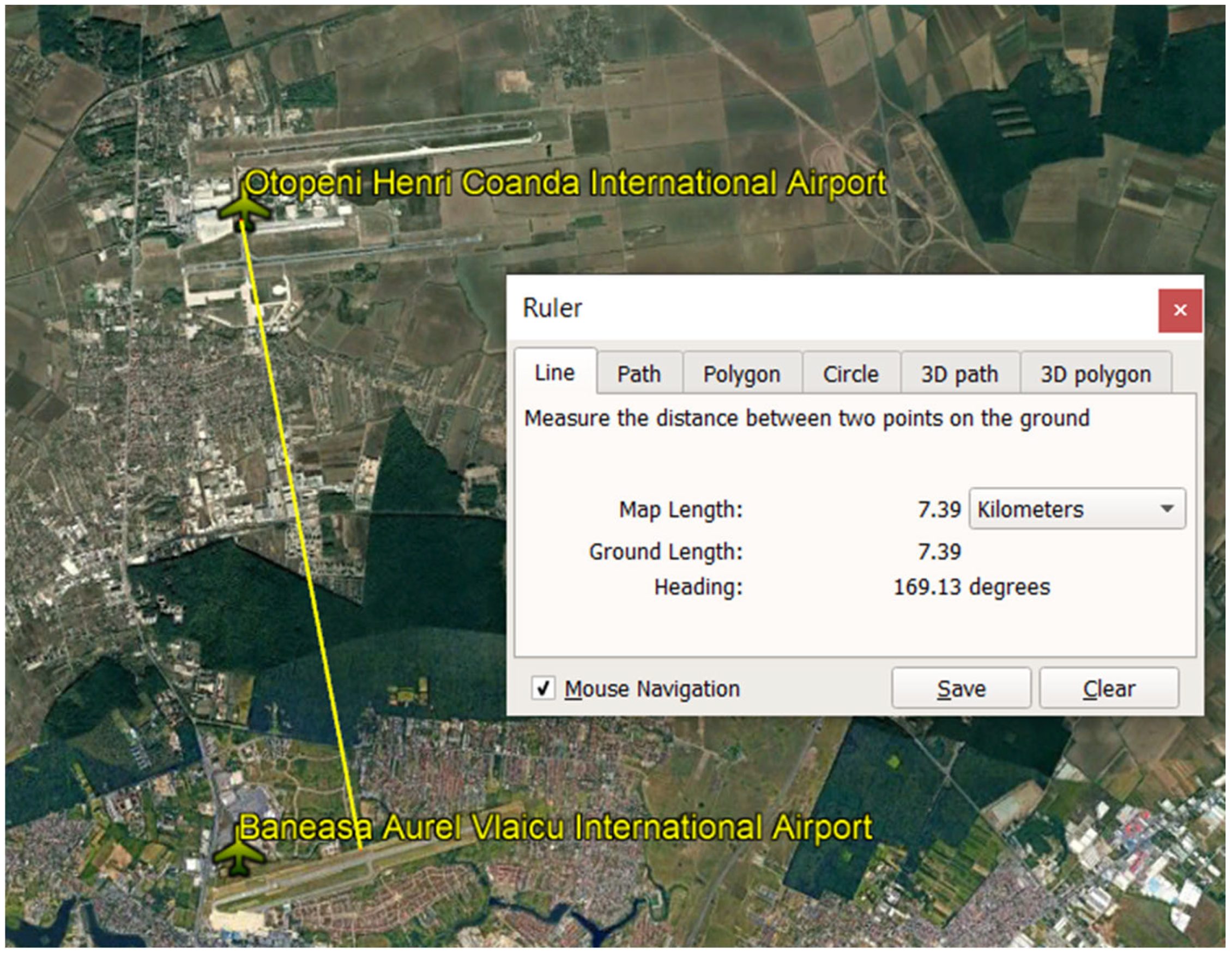



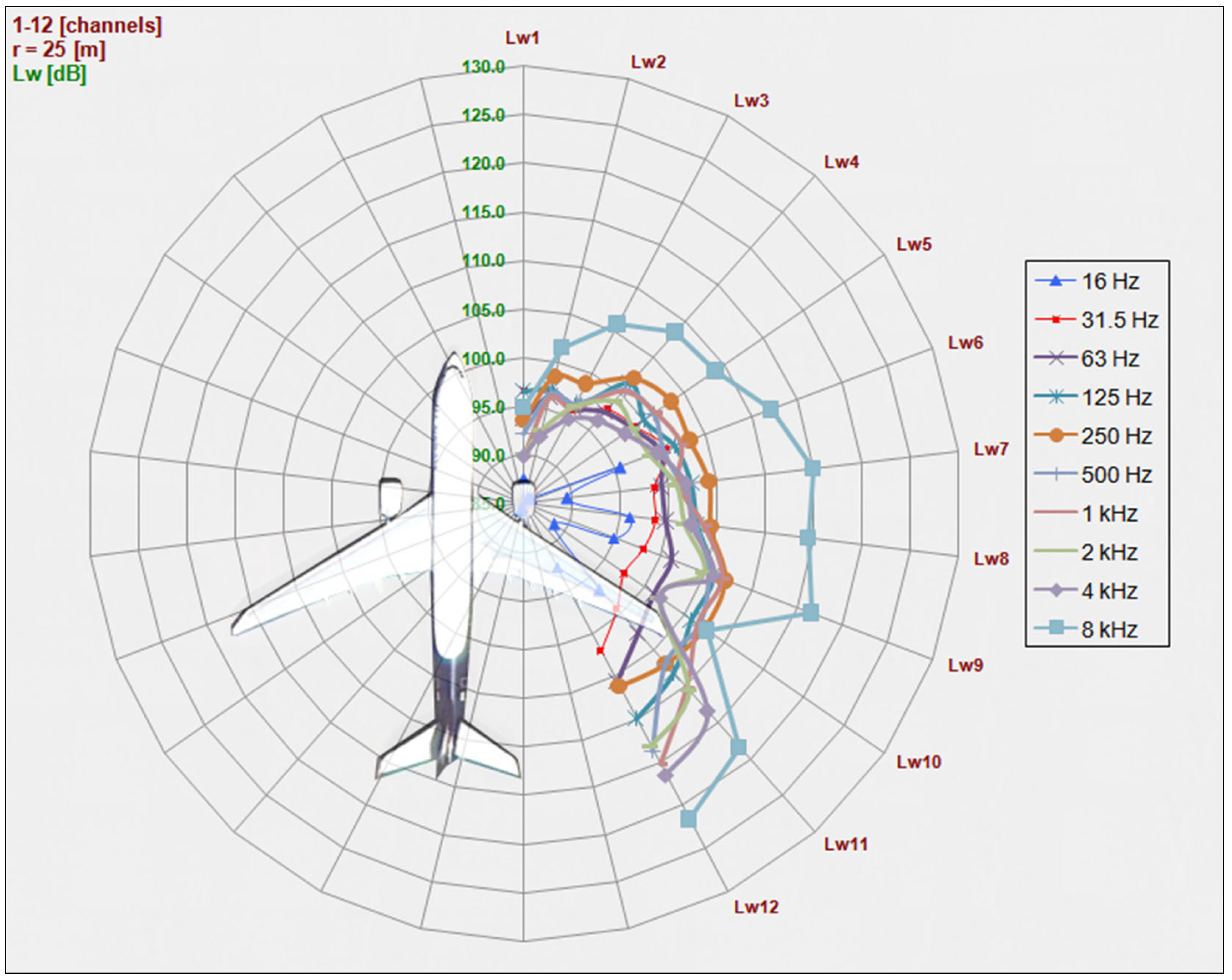

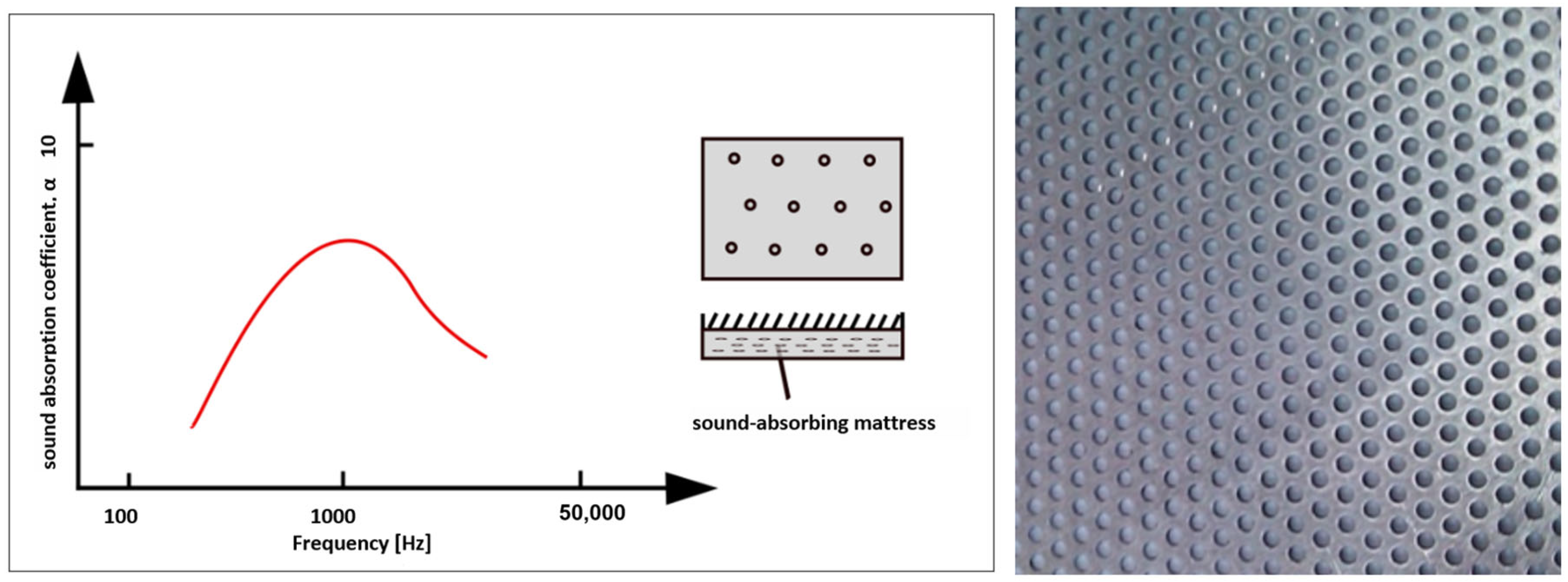
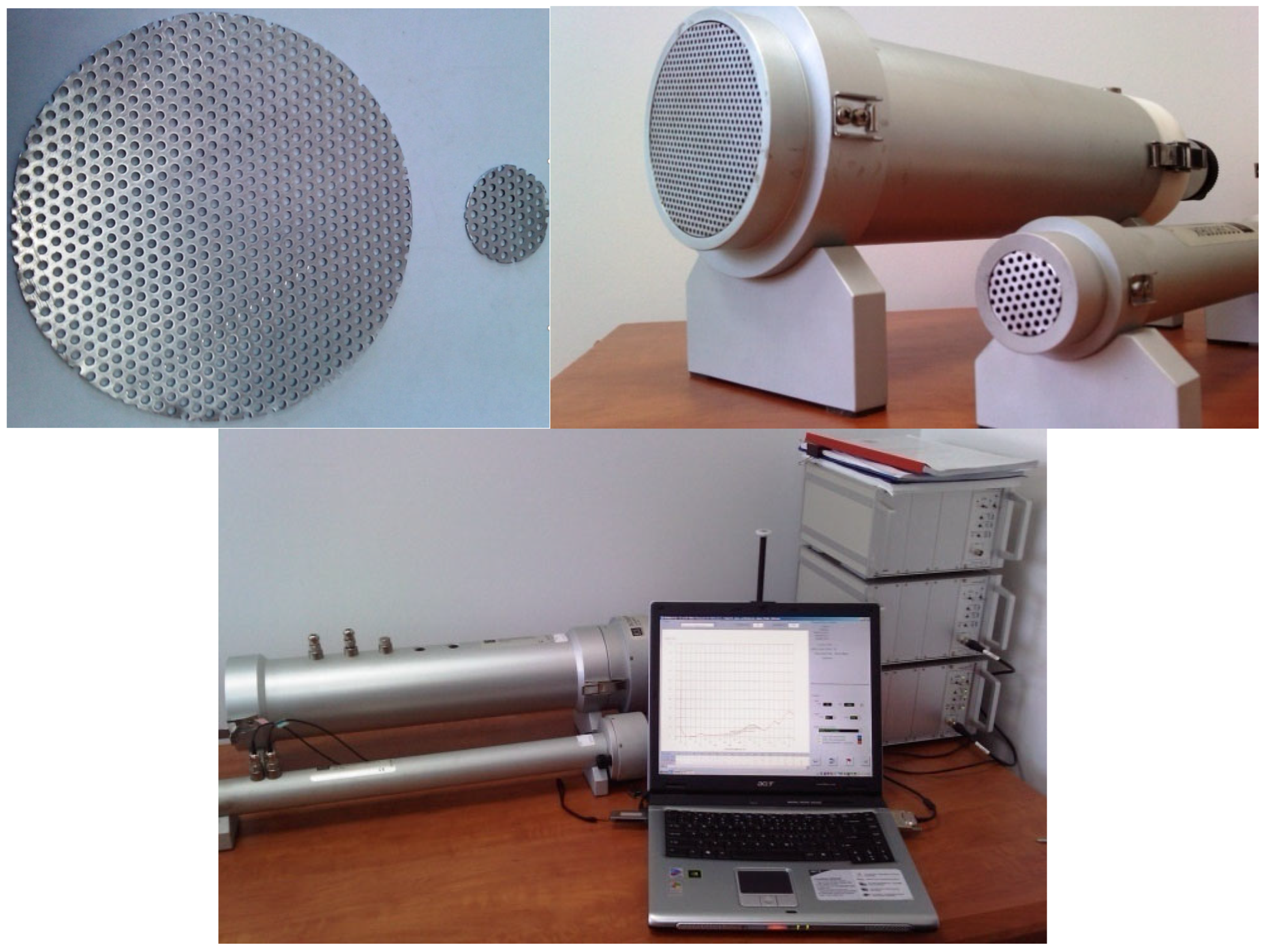


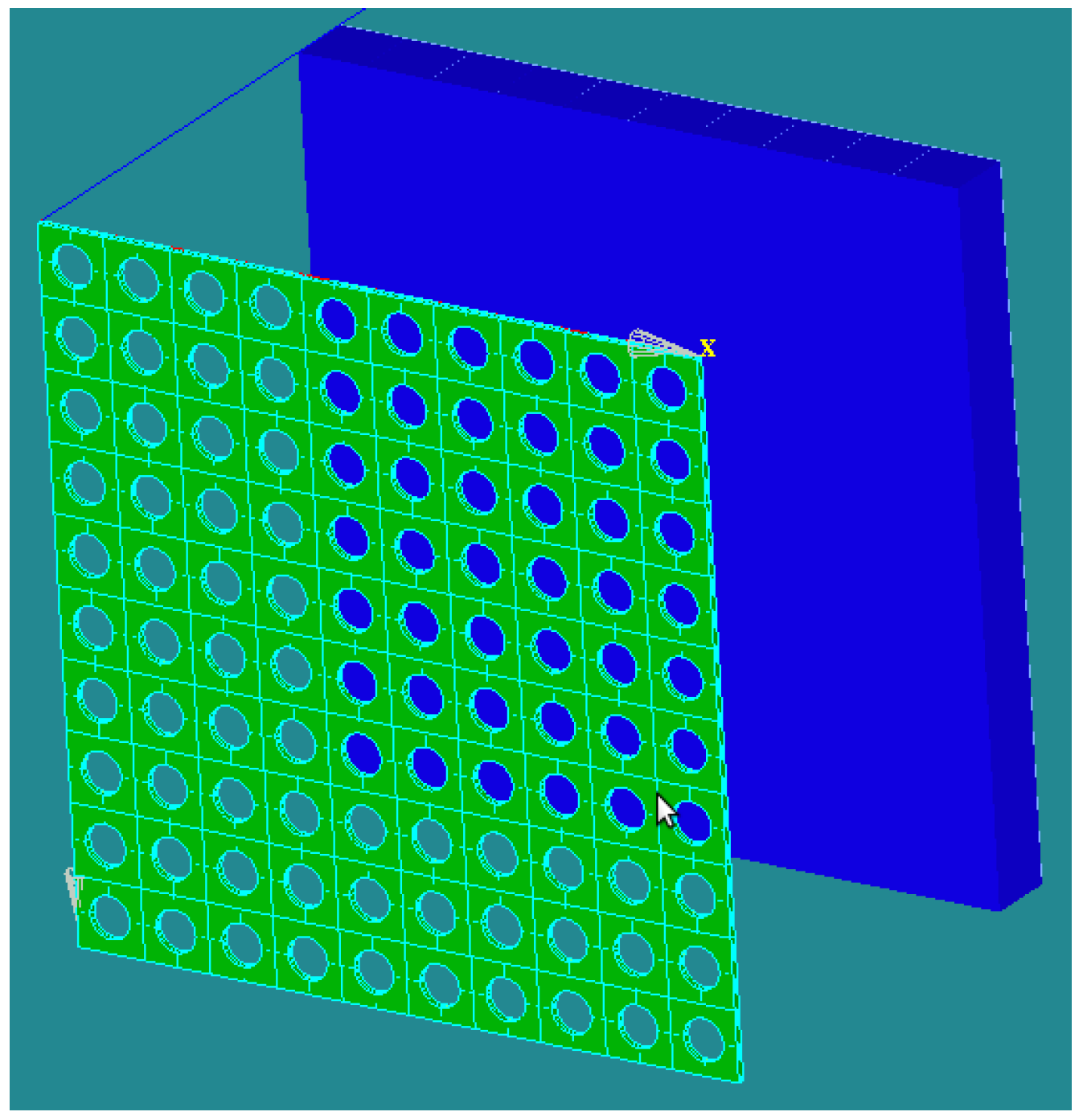
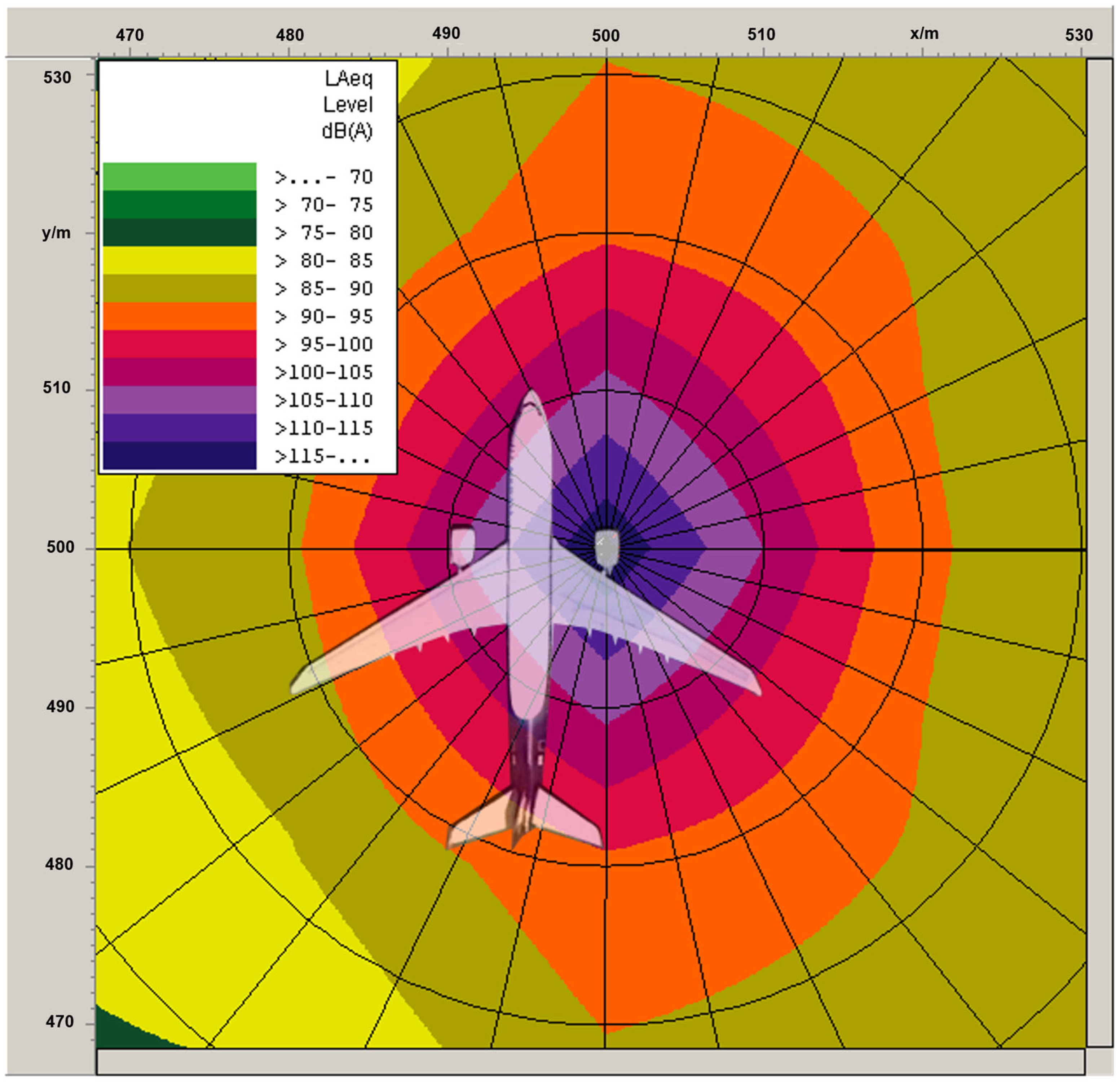
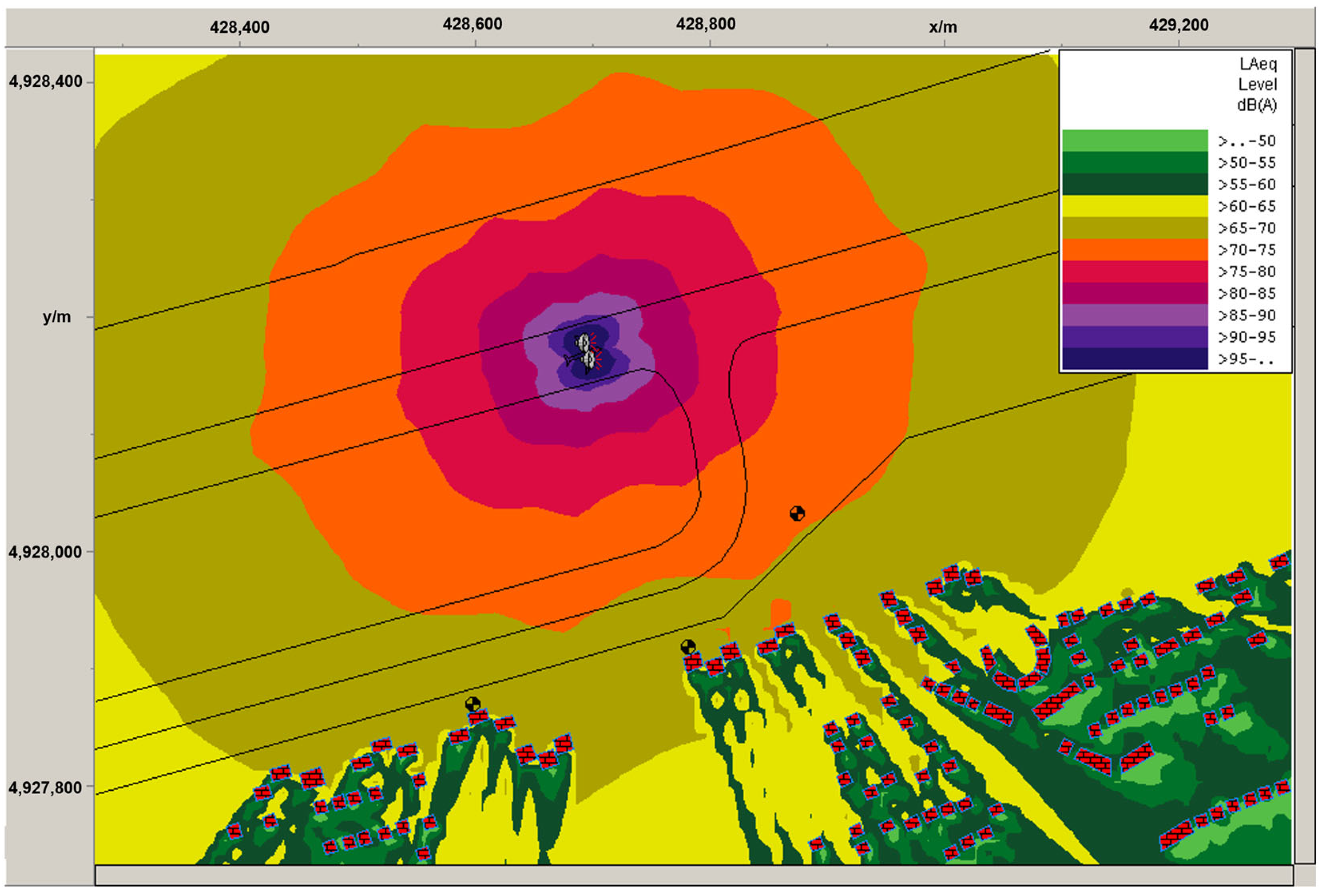
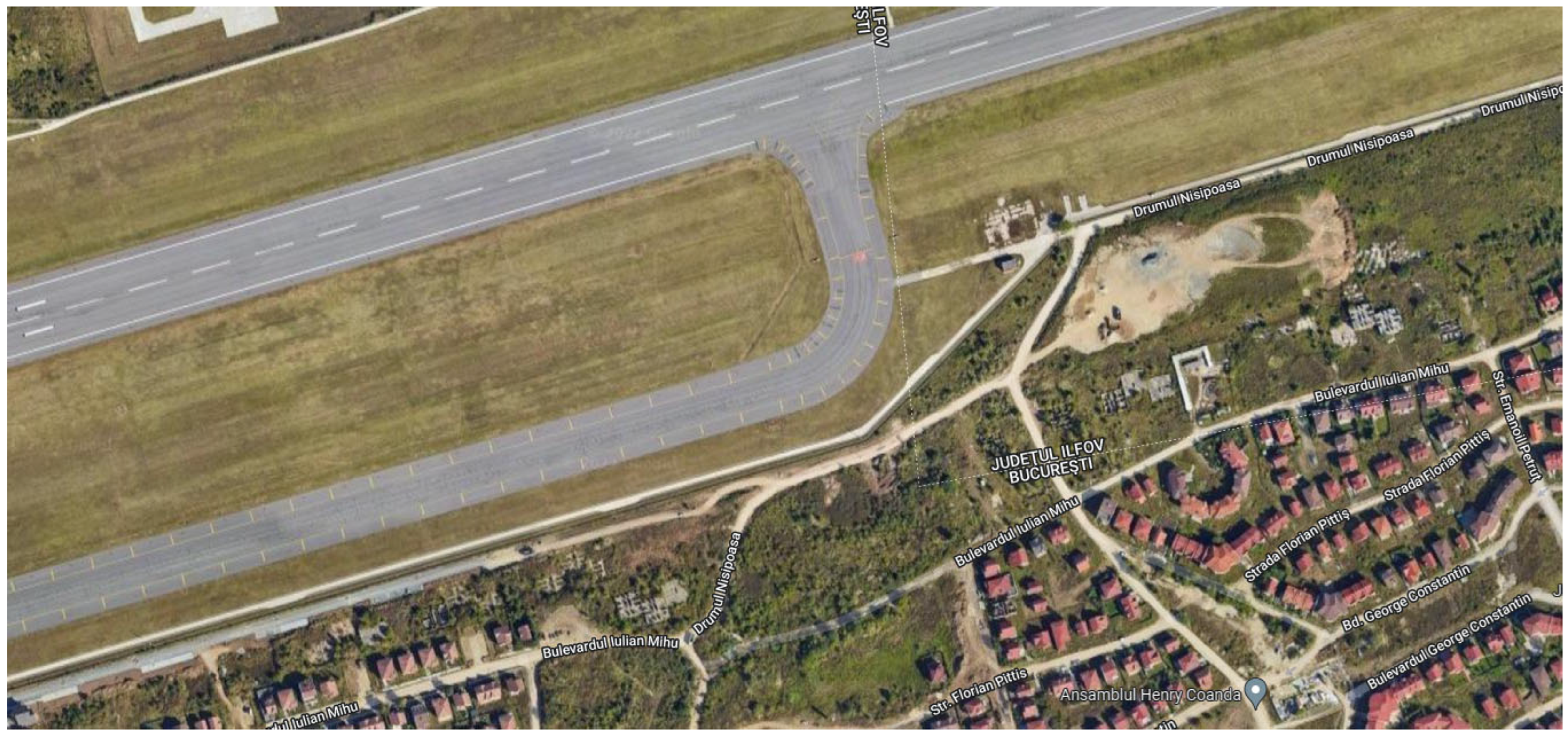
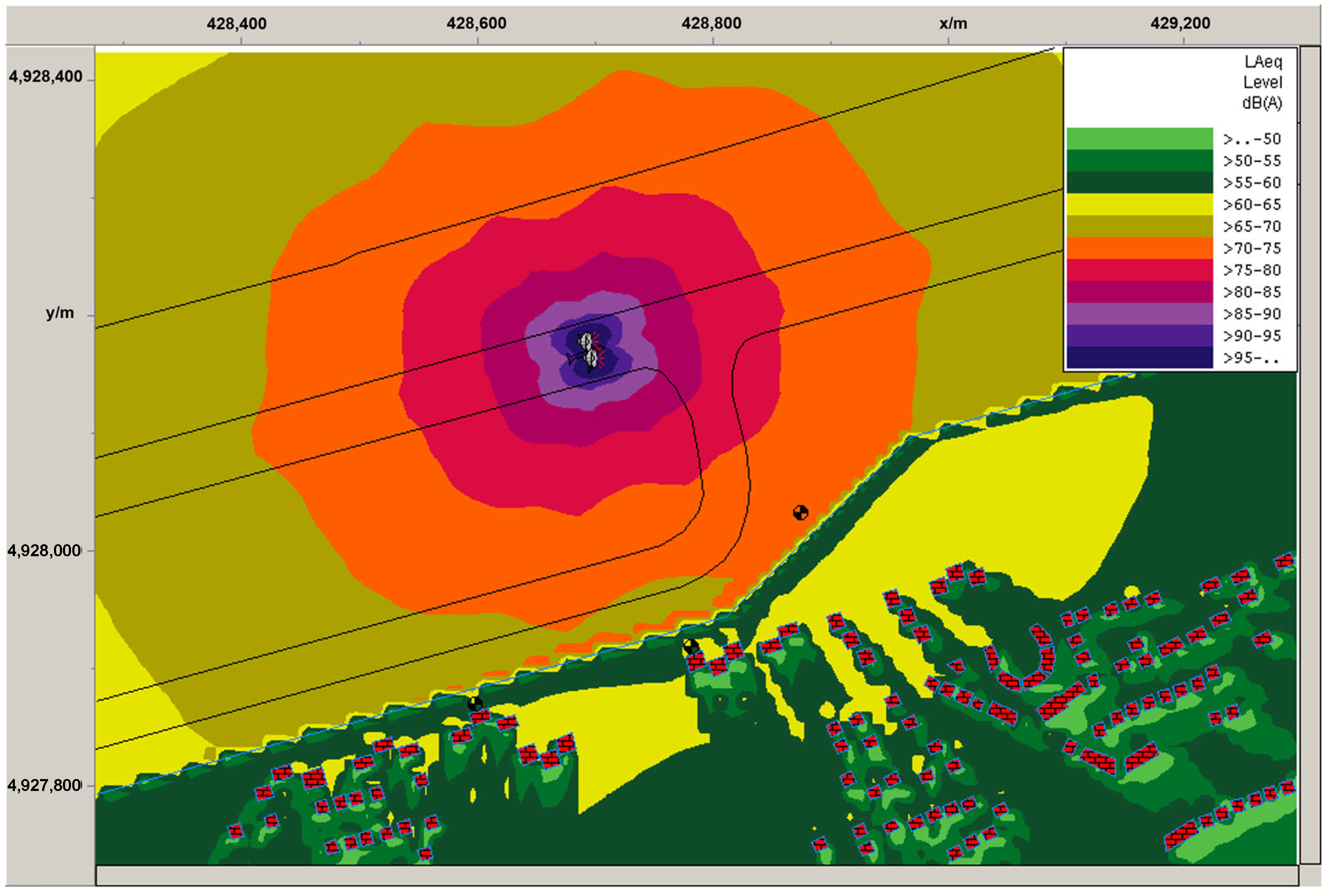
| 16 Hz | 31.5 Hz | 63 Hz | 125 Hz | 250 Hz | 500 Hz | 1 kHz | 2 kHz | 4 kHz | 8 kHz | |
|---|---|---|---|---|---|---|---|---|---|---|
| Lw1 | 87.6 | 96.6 | 93.7 | 96.5 | 93.5 | 92.2 | 89.8 | 90.1 | 89.9 | 94.9 |
| Lw2 | 84.5 | 96.9 | 96.3 | 97.1 | 98.4 | 96.7 | 96.2 | 92.8 | 92.1 | 101.5 |
| Lw3 | 84.2 | 95.8 | 96.1 | 96.4 | 98.9 | 96.6 | 96.1 | 96.3 | 94.8 | 105.8 |
| Lw4 | 85.7 | 98.0 | 97.6 | 101.5 | 102.2 | 100.6 | 100.4 | 99.1 | 96.5 | 108.5 |
| Lw5 | 85.9 | 99.0 | 98.7 | 100.1 | 103.4 | 101.2 | 101.4 | 98.6 | 97.6 | 109.0 |
| Lw6 | 95.6 | 100.7 | 100.1 | 101.7 | 103.3 | 100.3 | 102.3 | 98.9 | 99.6 | 112.2 |
| Lw7 | 89.5 | 98.5 | 99.3 | 102.4 | 104.2 | 101.4 | 101.0 | 100.8 | 101.8 | 115.0 |
| Lw8 | 95.9 | 98.6 | 99.7 | 103.0 | 104.4 | 102.9 | 103.7 | 101.7 | 102.4 | 114.5 |
| Lw9 | 94.8 | 98.1 | 101.2 | 105.8 | 107.2 | 105.3 | 106.8 | 104.8 | 105.9 | 116.6 |
| Lw10 | 88.7 | 97.5 | 101.2 | 106.0 | 107.6 | 106.9 | 106.7 | 101.9 | 102.0 | 107.9 |
| Lw11 | 96.8 | 99.4 | 102.7 | 108.2 | 107.0 | 107.0 | 110.3 | 110.6 | 113.5 | 118.4 |
| Lw12 | 92.3 | 102.0 | 105.6 | 109.9 | 106.1 | 113.6 | 115.2 | 113.1 | 116.5 | 121.6 |
| 16 Hz | 31.5 Hz | 63 Hz | 125 Hz | 250 Hz | 500 Hz | 1 kHz | 2 kHz | 4 kHz | 8 kHz | |
|---|---|---|---|---|---|---|---|---|---|---|
| Lw1 | 91.4 | 102.6 | 108.4 | 113.7 | 114.7 | 115.1 | 117.1 | 124.9 | 121.3 | 116.7 |
| Lw2 | 93.5 | 104.6 | 106.6 | 116.0 | 116.4 | 116.4 | 116.9 | 125.1 | 123.8 | 119.0 |
| Lw3 | 93.4 | 103.1 | 108.6 | 116.2 | 115.9 | 116.3 | 115.1 | 121.3 | 119.7 | 115.3 |
| Lw4 | 96.1 | 102.9 | 111.4 | 116.8 | 119.3 | 119.5 | 115.2 | 118.8 | 117.6 | 115.9 |
| Lw5 | 95.8 | 103.0 | 110.2 | 117.4 | 118.3 | 117.6 | 112.7 | 113.7 | 115.6 | 115.4 |
| Lw6 | 96.2 | 104.6 | 110.3 | 115.9 | 118.0 | 116.9 | 111.8 | 110.1 | 112.6 | 116.1 |
| Lw7 | 96.4 | 103.9 | 111.8 | 117.8 | 118.3 | 116.6 | 110.6 | 108.8 | 108.3 | 117.0 |
| Lw8 | 97.6 | 104.3 | 112.9 | 117.6 | 118.3 | 117.4 | 114.7 | 110.5 | 110.5 | 118.3 |
| Lw9 | 98.2 | 105.4 | 114.6 | 121.4 | 122.3 | 121.3 | 119.3 | 115.7 | 116.6 | 126.4 |
| Lw10 | 97.9 | 104.6 | 114.1 | 121.0 | 123.5 | 123.3 | 124.1 | 121.0 | 119.8 | 129.2 |
| Lw11 | 100.3 | 104.8 | 114.2 | 120.9 | 123.9 | 121.6 | 120.5 | 118.1 | 118.8 | 125.6 |
| Lw12 | 100.8 | 106.4 | 118.0 | 123.4 | 122.9 | 121.5 | 120.5 | 117.3 | 119.6 | 123.6 |
| Thickness (mm) | Perforation Diameter (mm) | Distance between the Centers of the Perforations (mm) | |
|---|---|---|---|
| plate_1 | 1 | 2 | 4 |
| plate_2 | 1 | 3 | 8 |
| plate_3 | 1 | 8 | 12 |
| plate_4 | 3 | 3 | 6 |
| plate_5 | 3 | 4 | 8 |
| Plate 1 | Plate 2 | Plate 3 | Plate 4 | Plate 5 | |
|---|---|---|---|---|---|
| The distance between the plate and the wall | 10 mm | ||||
| The resonance frequency [Hz] | 4702.48 | 3084.152 | 3716.52 | 3263 | 3045.22 |
| The minimum frequency [Hz] | 2143.48 | 1792.10 | 1956.11 | 1842.73 | 1780.59 |
| The maximum frequency [Hz] | 10,316.56 | 5307.73 | 7061.22 | 5777.92 | 5208.01 |
| The distance between the plate and the wall | 20 mm | ||||
| The resonance frequency [Hz] | 3325.158 | 2180.82 | 2627.98 | 2307.29 | 2153.29 |
| The minimum frequency [Hz] | 1181.90 | 1043.24 | 1111.02 | 1064.73 | 1038.28 |
| The maximum frequency [Hz] | 9354.98 | 4558.87 | 6216.13 | 4999.92 | 4465.70 |
| The distance between the plate and the wall | 30 mm | ||||
| The resonance frequency [Hz] | 2714.98 | 1780.64 | 2145.74 | 1883.89 | 1758.16 |
| The minimum frequency [Hz] | 819.67 | 744.30 | 782.07 | 756.46 | 741.47 |
| The maximum frequency [Hz] | 8992.75 | 4259.93 | 5887.17 | 4691.65 | 4168.89 |
| The distance between the plate and the wall | 40 mm | ||||
| The resonance frequency [Hz] | 2351.24 | 1542.08 | 1858.26 | 1631.50 | 1522.61 |
| The minimum frequency [Hz] | 628.13 | 580.54 | 604.77 | 588.42 | 578.70 |
| The maximum frequency [Hz] | 8801.21 | 4096.17 | 5709.87 | 4523.61 | 4006.12 |
| The distance between the plate and the wall | 50 mm | ||||
| The resonance frequency [Hz] | 2103.01 | 1379.27 | 1662.08 | 1459.26 | 1361.86 |
| The minimum frequency [Hz] | 509.38 | 476.53 | 493.43 | 482.07 | 475.23 |
| The maximum frequency [Hz] | 8682.46 | 3992.16 | 5598.54 | 4417.26 | 3902.65 |
| The distance between the plate and the wall | 60 mm | ||||
| The resonance frequency [Hz] | 1919.78 | 1259.10 | 1517.26 | 1332.11 | 1243.20 |
| The minimum frequency [Hz] | 428.48 | 404.42 | 416.89 | 408.53 | 403.45 |
| The maximum frequency [Hz] | 8601.55 | 3920.04 | 5522.00 | 4343.71 | 3830.87 |
| The distance between the plate and the wall | 70 mm | ||||
| The resonance frequency [Hz] | 1777.37 | 1165.70 | 1404.71 | 1233.30 | 1150.98 |
| The minimum frequency [Hz] | 369.79 | 351.40 | 360.99 | 354.57 | 350.65 |
| The maximum frequency [Hz] | 8542.87 | 3867.02 | 5466.10 | 4289.76 | 3778.07 |
| The distance between the plate and the wall | 80 mm | ||||
| The resonance frequency [Hz] | 1662.58 | 1090.41 | 1313.99 | 1153.64 | 1076.65 |
| The minimum frequency [Hz] | 325.26 | 310.74 | 318.35 | 313.27 | 310.14 |
| The maximum frequency [Hz] | 8498.34 | 3826.36 | 5423.46 | 4248.45 | 3737.56 |
| The distance between the plate and the wall | 90 mm | ||||
| The resonance frequency [Hz] | 1567.49 | 1028.05 | 1238.84 | 1087.67 | 1015.07 |
| The minimum frequency [Hz] | 290.31 | 278.56 | 284.74 | 280.62 | 278.07 |
| The maximum frequency [Hz] | 8463.39 | 3794.18 | 5389.85 | 4215.80 | 3705.49 |
| The distance between the plate and the wall | 100 mm | ||||
| The resonance frequency [Hz] | 1487.06 | 975.29 | 1175.27 | 1031.85 | 962.98 |
| The minimum frequency [Hz] | 262.15 | 252.44 | 257.57 | 254.15 | 252.03 |
| The maximum frequency [Hz] | 8435.23 | 3768.06 | 5362.67 | 4189.33 | 3679.45 |
Disclaimer/Publisher’s Note: The statements, opinions and data contained in all publications are solely those of the individual author(s) and contributor(s) and not of MDPI and/or the editor(s). MDPI and/or the editor(s) disclaim responsibility for any injury to people or property resulting from any ideas, methods, instructions or products referred to in the content. |
© 2023 by the authors. Licensee MDPI, Basel, Switzerland. This article is an open access article distributed under the terms and conditions of the Creative Commons Attribution (CC BY) license (https://creativecommons.org/licenses/by/4.0/).
Share and Cite
Toma, A.C.; Cican, G.; Crunteanu, D.-E. Enhancing Air Traffic Management and Reducing Noise Impact: A Novel Approach Integrating Băneasa Airport with Otopeni RO Airport. Appl. Sci. 2023, 13, 9139. https://doi.org/10.3390/app13169139
Toma AC, Cican G, Crunteanu D-E. Enhancing Air Traffic Management and Reducing Noise Impact: A Novel Approach Integrating Băneasa Airport with Otopeni RO Airport. Applied Sciences. 2023; 13(16):9139. https://doi.org/10.3390/app13169139
Chicago/Turabian StyleToma, Adina Cristina, Grigore Cican, and Daniel-Eugeniu Crunteanu. 2023. "Enhancing Air Traffic Management and Reducing Noise Impact: A Novel Approach Integrating Băneasa Airport with Otopeni RO Airport" Applied Sciences 13, no. 16: 9139. https://doi.org/10.3390/app13169139
APA StyleToma, A. C., Cican, G., & Crunteanu, D.-E. (2023). Enhancing Air Traffic Management and Reducing Noise Impact: A Novel Approach Integrating Băneasa Airport with Otopeni RO Airport. Applied Sciences, 13(16), 9139. https://doi.org/10.3390/app13169139







